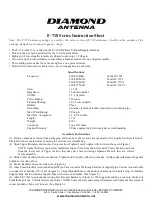
9.7 Event Timing Inputs
75
to time, latency likewise varies. However, response time will, in general, never be less than a few
hundred microseconds nor greater than 10 milliseconds.
9.7.2
Deviation Measurement
The event input can also be configured to display measured event times as 1 pulse-per-second (1
PPS) deviation measurements. The intended purpose of the deviation measurement function is to
allow comparison of an external 1-PPS signal to the clock’s precision internal 1-PPS signal. The
clock determines the mean time difference between the two signals, which can be displayed on the
front panel or collected through either COM1 or COM2.
9.7.3
Measurement Principle
The measurement technique employed for 1-PPS Deviation uses the same time determination and
recording scheme used for Event Time measurement (refer to paragraph above), but makes the
assumption that the input signal is periodic and continuous. Also, the operation of the circular
memory buffer is modified somewhat, in that recording does not stop after the first 300 events;
new event data is given priority over existing data, and will overwrite it. Since the incoming signal
is at 1 Hz and the circular buffer holds 300 events, each event time record will be overwritten once
every 300 seconds.
Once every second the processor looks at the most recent group of 16 events. To compute devi-
ation, it uses only the portion of the event data describing fractional seconds (e.g. values between
0.0000000 and 0.9999999). The 16 fractional-second values are normalized around 0.0000000, so
that the range of results from the deviation computations will be centered on zero (
±
0.5 seconds).
It also computes the statistical Mean and Sigma (Standard Deviation) values on the 16 values,
which are then be displayed on the front panel or output via either COM1 or COM2.
9.7.4
Event Timer Input Channel Configuration
Adjustments to both the hardware and firmware configuration are required for the Model 1094B to
receive input signals and to record events. The hardware configuration is described in Section 5.5,
where jumpers JMP2 and JMP3 are identified. Discussion of the configuration through firmware
follows in this section and in Section 10.3.5.
9.7.5
Configuring Event/Deviation Operation
There are two methods for configuring the Model 1094B for either event recording or 1 PPS devia-
tion measurement: (1) through the front panel interface, and (2) through COM1 or COM2 RS-232
serial ports.
Configuring Event/Deviation Mode from Front Panel Interface
Press the SETUP key repeatedly until you reach the menu item that states:
SET EVENT/DEVIATION?
Press ENTER and the display should read,
















































